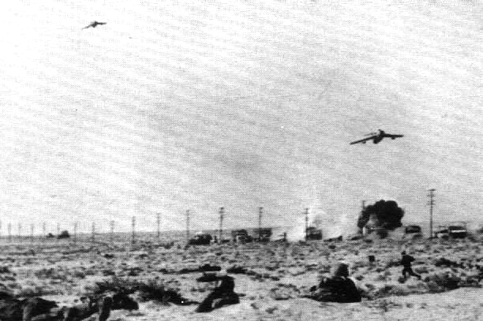- by Yuval Yoaz, Haaretz. June 2005.

- Photo: 1967 War.
Visitors to Canada Park, near Latrun, might notice the remains of houses, ancient cemeteries, and signs of the bustling life that prevailed there until not long ago. But they wouldn’t know that the remains belong to two neighboring Palestinian villages that existed in the area until the Six Day War in 1967.
The Jewish National Fund (JNF), which runs the park, has posted explanatory signs detailing life in the area in previous eras, including the time of the Second Temple and the Hellenic, Roman, and even monarchic periods. Yet, the inscriptions on the signs don’t divulge that Palestinians lived in the area over many years.
The omission of the “Palestinian period” in the area by State authorities and the JNF is the subject of a petition submitted to the High Court of Justice on Thursday by the organization “Zochrot,” through Adv. Michael Sfard. The organization was founded three years ago with the aim of “forwarding public discussion that is open to diverse histories.” The leader of the movement, Eitan Bronstein, says that the intention is to “raise awareness among the Jewish public in of the Palestinian Nakba. Acknowledging the Nakba is part of taking responsibility for what was done to the Palestinians – which is itself a precondition for true reconciliation between the peoples.”
The territory of Canada Park lies partly within the green line, and partly in the West Bank . Until 1967 the area included a demilitarized zone between and , which was considered “no man’s land,” and since the Six Day War it has been considered part of . The petition by the Zochrot organization was preceded by two years of correspondence with the JNF and the Civil Administration in the Territories, with the aim of bringing about the creation of signs in the park that would tell the stories of the Palestinian villages. “The JNF does not view itself as dealing with subjects that have political significance,” wrote Leora Tsoref, advisor to the JNF directorship, to the organization, “and therefore this should be forwarded to state bodies concerned with the matter.”
Later, following additional communications, the legal advisor of the Civil Administration decided to consult with the Ministry of Justice on the matter. About six months ago Maj. Ehud Brosh, assistant to the legal advisor of the Civil Administration, notified Adv. Sfard that “according to the advice of the Ministry of Justice it has been decided to approve the request” to post the signs in the area.
At the request of the Administration, Zochrot forwarded the proposed text for the signs. The text detailed a historical account of the two Palestinian villages in the area, Imwas and Yalu, which were destroyed in 1967. The text read, in part: “Imwas was an ancient Palestinian village. The village was destroyed during the Six Day War when the IDF gained control of the area, at a time when 2,000 people inhabited the village. The refugees of Imwas have lived since then in and the Ramallah area. The village had two schools, two mosques and a number of water wells.” But in the end the Administration gave notice that it intended to inscribe its own wording on the signs. Months passed, and the signs were never posted.
“The purpose of posting signs on the history of the park,” writes Adv. Sfard in the petition, “is to provide visitors with information about the history of the area and in order to forward values such as knowledge of the land and its heritage. Omitting selective passages from local history is an unreasonable and extreme decision, which mars these values. It raises the suspicion that the refusal to post the signs in the area is based on political motivations aimed at preventing visitors to the site from becoming acquainted with its Arab past. The military commander is not ‘minister of history’ and is not authorized to prefer one historical narrative over another.”
” Canada Park is an amazing example of a place where there are many signs that tell different histories, but make no mention of hundreds of years of Palestinian history,” says Bronstein, “even while there are actual remains of the villages there. There is a cemetery, there are remains of houses. It’s not a park that people visit to have a barbecue, but to learn about what was here.” Judge Miriam Naor of the High Court of Justice has instructed the State to respond to the petition within a month’s time.


